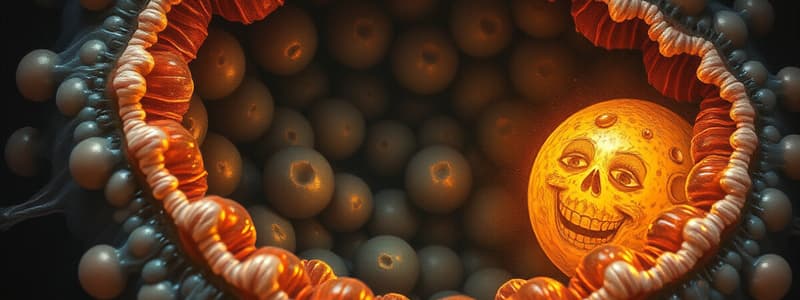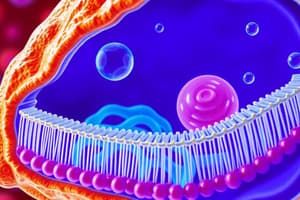Podcast
Questions and Answers
What is the primary role of anchoring proteins in the cell membrane?
What is the primary role of anchoring proteins in the cell membrane?
- Catalyze reactions inside or outside the membrane
- Label cells as normal or abnormal
- Transport solutes through the membrane
- Attach the cell membrane to inside or outside structures (correct)
How do recognition proteins contribute to the immune response?
How do recognition proteins contribute to the immune response?
- They create channels for solute movement
- They label cells as normal or abnormal (correct)
- They facilitate chemical reactions
- They transport nutrients into the cell
What function do membrane carbohydrates primarily serve?
What function do membrane carbohydrates primarily serve?
- Facilitate lubrication and protection (correct)
- Aid in cell division
- Synthesize proteins
- Provide structural support
Which component is NOT included in the cytoplasm?
Which component is NOT included in the cytoplasm?
What is the role of microvilli in a cell?
What is the role of microvilli in a cell?
Which organelle is primarily responsible for protein synthesis?
Which organelle is primarily responsible for protein synthesis?
What is the function of cilia in cells?
What is the function of cilia in cells?
Which type of organelle forms the spindle apparatus during cell division?
Which type of organelle forms the spindle apparatus during cell division?
Which statement best describes the role of the cell membrane?
Which statement best describes the role of the cell membrane?
What are the two classes of cells in the human body?
What are the two classes of cells in the human body?
What is the primary function of integral proteins in the cell membrane?
What is the primary function of integral proteins in the cell membrane?
What does the phospholipid bilayer of the cell membrane consist of?
What does the phospholipid bilayer of the cell membrane consist of?
Which of the following statements is NOT true about the cell theory?
Which of the following statements is NOT true about the cell theory?
What fluid surrounds human body cells, providing an external environment?
What fluid surrounds human body cells, providing an external environment?
Which of the following best defines cytology?
Which of the following best defines cytology?
Which organelle is responsible for maintaining the genetic code of a cell?
Which organelle is responsible for maintaining the genetic code of a cell?
What does a gene primarily provide instructions for?
What does a gene primarily provide instructions for?
What is the role of RNA polymerase during gene activation?
What is the role of RNA polymerase during gene activation?
What do codons in the mRNA strand represent?
What do codons in the mRNA strand represent?
What happens to the mRNA strand after transcription is complete?
What happens to the mRNA strand after transcription is complete?
Which of the following statements about the genetic code is true?
Which of the following statements about the genetic code is true?
What is the first step in protein production?
What is the first step in protein production?
During RNA processing, which change occurs?
During RNA processing, which change occurs?
Which of these is NOT a nitrogenous base found in DNA?
Which of these is NOT a nitrogenous base found in DNA?
What is the primary function of the smooth endoplasmic reticulum?
What is the primary function of the smooth endoplasmic reticulum?
What is true about rough endoplasmic reticulum (RER)?
What is true about rough endoplasmic reticulum (RER)?
Which organelle is primarily responsible for modifying and packaging proteins?
Which organelle is primarily responsible for modifying and packaging proteins?
What do peroxisomes do?
What do peroxisomes do?
What is the role of mitochondria in the cell?
What is the role of mitochondria in the cell?
How is genetic information stored in the nucleus?
How is genetic information stored in the nucleus?
What distinguishes lysosomes from other organelles?
What distinguishes lysosomes from other organelles?
What type of ribosomes are found attached to the endoplasmic reticulum?
What type of ribosomes are found attached to the endoplasmic reticulum?
What role does tRNA play in protein synthesis?
What role does tRNA play in protein synthesis?
How does a mutation affect gene function?
How does a mutation affect gene function?
What is the main characteristic of selectively permeable membranes?
What is the main characteristic of selectively permeable membranes?
What is one major mechanism of transport across cell membranes?
What is one major mechanism of transport across cell membranes?
What provides electrical energy to muscles and the nervous system?
What provides electrical energy to muscles and the nervous system?
Which type of RNA carries the anticodon necessary for protein synthesis?
Which type of RNA carries the anticodon necessary for protein synthesis?
Which of the following statements about polyribosomes is true?
Which of the following statements about polyribosomes is true?
In the context of amino acids, how is an anticodon structured?
In the context of amino acids, how is an anticodon structured?
Study Notes
Cellular Organization and Theory
- Cell theory: foundational principles in biology by Robert Hooke (1665) state that all living organisms are composed of cells, cells arise from preexisting cells, and cells are the smallest units of life maintaining homeostasis.
- Two primary types of human cells: sex cells (reproductive) and somatic cells (body cells excluding sex cells).
- The cell membrane separates cytoplasm from extracellular fluid and controls transport of substances in and out of the cell.
Cell Membrane Structure and Function
- Composed of a phospholipid bilayer with hydrophilic heads facing aqueous environments, providing a selective barrier.
- Membrane proteins:
- Integral proteins: embedded within the membrane.
- Peripheral proteins: attached to the inner or outer membrane surface.
- Functions include anchoring, recognition, acting as enzymes, receptors, carriers, and channels for regulation of movement across the membrane.
- Membrane carbohydrates:
- Extend outside the membrane for lubrication, protection, specificity in binding, and immune recognition.
Cytoplasm and Organelles
- Cytoplasm consists of cytosol (intracellular fluid) and organelles, which have distinct functions.
- Nonmembranous organelles:
- Cytoskeleton: provides structure and support.
- Microvilli: increase surface area for absorption.
- Centrioles: assist in cell division.
- Cilia: move fluids over cell surfaces.
- Ribosomes: sites of protein synthesis.
- Membranous organelles:
- Endoplasmic reticulum: network of membranes; smooth ER synthesizes lipids, rough ER synthesizes proteins and glycoproteins.
- Golgi apparatus: modifies and packages proteins for secretion.
- Lysosomes: break down waste and cellular debris using enzymes.
- Peroxisomes: detoxify harmful substances and break down fatty acids.
- Mitochondria: powerhouse of the cell, producing ATP through aerobic metabolism.
The Nucleus
- Largest organelle, serves as the control center of the cell, housing DNA.
- Nuclear envelope: double membrane with nuclear pores for communication.
- Contains chromatin (loosely coiled DNA in non-dividing cells) and chromosomes (tightly coiled DNA in dividing cells).
Genetic Code and Protein Synthesis
- DNA encodes the instructions for synthesizing proteins, each comprising unique amino acid sequences.
- Genes are segments of DNA containing codes for protein synthesis, denoted by triplet sequences of nitrogenous bases (A, T, C, G).
- Process of transcription: DNA uncoils, RNA polymerase creates mRNA from the DNA template, substituting uracil for thymine.
- Translation occurs in the cytoplasm at ribosomes, where mRNA codons direct tRNA to bring corresponding amino acids, forming polypeptide chains.
Cell Cycle and Mitosis
- The cell cycle encompasses the stages of cell growth and division.
- Mitosis: cellular process where a single cell divides into two identical daughter cells, ensuring genetic consistency.
Cell Membrane Transport Mechanisms
- Selectively permeable membrane: allows certain substances to pass freely while restricting others.
- Transport methods:
- Passive transport: diffusion (movement of molecules from high to low concentration), no energy required.
- Active transport: requires ATP to move substances against concentration gradients.
- Vesicular transport: uses vesicles for bulk transport of materials in and out of the cell.
Transmembrane Potential
- The difference in charge across the cell membrane contributes to transmembrane potential: slightly negative inside and slightly positive outside.
- This electrical gradient is crucial for the functioning of muscles, nerve cells, and glands.
Studying That Suits You
Use AI to generate personalized quizzes and flashcards to suit your learning preferences.
Related Documents
Description
Test your knowledge on the cellular level of organization with this quiz. It covers essential aspects such as the cell membrane structure, organelle functions, genetic code, and the processes of protein synthesis and mitosis. Ideal for students of biology looking to reinforce their understanding of cells.




